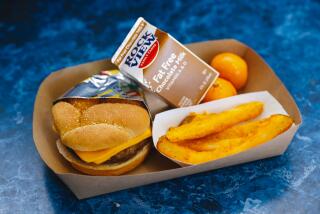An Early Start on Good Eating Habits : The Lunch Box Can Pack Important Nutritional Lessons for Children
- Share via
School children get more out of a lunch box than energy. The lunch box can also be a learning tool that teaches good eating habits.
There are two major reasons parents should be concerned about what they put into their child’s lunch, said William H. Weidman, pediatrician at the Mayo Medical School in Rochester, Minn., and a member of the American Heart Assn.’s Nutrition Committee.
One is that the incidence of obesity in children is increasing. “It’s becoming a major health problem in the United States,” Weidman said.
“No. 2 is that Americans as a whole, and that includes children, eat diets that contain more fat than they need. And that puts them at increased risk of a high blood cholesterol, which may lead to heart disease as adults.”
The AHA recommends that every healthy American older than 2 limit fat to less than 30% of a day’s total calories with only one-third of that amount coming from saturated fats.
Habits Carried Into Adulthood
“Children who eat diets high in fat and cholesterol in childhood tend to carry those habits into adulthood,” Weidman said.
Several studies have shown that children with high blood cholesterol levels continue to take high levels into adulthood unless steps are taken to lower those levels either through diet or medication, he said.
It is very likely that the changes in arteries that eventually lead to heart attacks may begin to develop in teen-agers, he said.
Jo Ann Carson, a registered dietitian and director of clinical dietetics at the University of Texas Southwestern Medical Center at Dallas, said the typical school lunch mirrors the major problems in the American diet.
“We need to eat more fresh fruits and vegetables and whole grain cereals and less fat,” she said. “The typical lunch of cookies, chips and a sandwich can be fairly high in fat and doesn’t provide enough fresh fruits and vegetables.”
Simple changes can make the typical lunch much healthier, Carson said.
Instead of white bread, try whole-wheat, rye or another whole-grain bread. Instead of croissants, which are high in fat, use bagels.
Significant Fat Reduction
“If you use mustard (rather than mayonnaise) on a sandwich, or maybe even nothing, you’ve significantly reduced the fat. Instead of using high-fat sandwich meat--like bologna, salami, or pickle loaf--get turkey cold cuts,” she said.
Carson said parents should read the lable when buying lunch meats and look for those that are at least 90% lean. For packages that list the amount of fat in grams, she recommends as a rough guideline selecting meat that has more grams of protein than grams of fat per slice.
“Some other lean meats that are better than cold cuts are your own sliced turkey, chicken or lean roast beef,” she said. Another good idea is making tuna or chicken salad and substituting yogurt for half the mayonnaise.
To keep meat or salad sandwiches cool and safe to eat, freeze a small can of juice or container of low-fat yogurt to pack in the lunch. As it thaws, it will keep everything cool.
Another alternative would be to make a week’s sandwiches at one time, and freeze them. This saves last-minute preparation and keeps the sandwiches safe longer. Meat, chicken, turkey and peanut butter freeze well. Mayonnaise does not.
“Instead of chips and cookies, I would send fresh vegetables to munch on like broccoli florets, carrot sticks or you might try something that’s not already on the child’s list of ‘don’t likes,’ ” she said. “One I use is raw jicama--a Mexican vegetable. I would say it tastes like a cross between an apple and a potato. I cut it into sticks and put it in a bag.”
More Substitutes
Other good substitutes for snack cakes are fresh grapes, strawberries, apples, oranges, small containers of applesauce or raisins and healthy cookies once in a while.
Carson defines healthy cookies as those that are “something other than just sugar and fat.” Examples include peanut butter cookies, which contain protein, and oatmeal-raisin cookies, which provide fiber.
Certain children and certain ages present special problems, said Carson, who has two children.
“When you’re dealing with preschoolers and they go through a stage where they want the same thing day after day, present them with a variety of things. But if all they will eat is peanut butter and jelly, I don’t think that’s a big problem if you are using whole-grain breads and including grapes, carrot sticks or juice and low-fat milk.”
Elementary school children should get about three cups of low-fat or skim milk a day, she said, “If you don’t have it at lunchtime, it’s difficult to get it all in.”
For children who don’t like milk, low-fat or “lite” cheese and yogurt are good ways to give them the calcium, riboflavin and protein of milk, she said.
“My youngest likes those little bitty cheese cubes that are wrapped individually,” she said. “You might try cheese and crackers instead of a sandwich.”
For young children, clever packaging can help overcome resistance and peer pressure.
“Carrot and jicama sticks may be more acceptable in a plastic container with a picture of Garfield or some other character on the top,” she said.
Carson warns against letting food become a battleground.
“My key nutritional message is variety and moderation. There’s nothing life-threatening about a marshmallow Easter bunny now and then. It’s important to be very positive about eating rather than saying, ‘No, you can’t have that.’ Instead, say how much you like the healthy things that are going in the lunch.”
Setting a Good Example
Both Weidman and Carson recommend that parents set a good example and get the child involved in planning healthy meals.
“The best thing a parent can do is first set a good example at home and make changes in the diet gradually,” Weidman said.
“Let the child participate, do it slowly and make sure everyone in the family is having the same thing,” he said.
“You should be vigilant only in that you set the example and show them what to do, but you can’t watch them every minute. If you are too vigilant, they will rebel.”
Carson said getting children involved helps ensure that they will eat their own lunch and not swap with friends.
After school is a good time to fight childhood obesity by encouraging exercise instead of hours spent in front of the television, Weidman said.
“There is a good correlation between time spent with the television and being overweight,” he said.
“What can parents do? What they can do is set an example. It has to be a family endeavor. They start walking three times a week and taking the child with them.
“And there’s something else they can do. They can say ‘no.’ They can set limits for the child.”
Weidman strongly encourages parents to limit the child’s TV-viewing time and give the child the responsibility of deciding what shows to watch.
“That’s important for other things, such as reading and studying. The problem is greater than a balanced diet. They have to have a balanced life,” he said.






